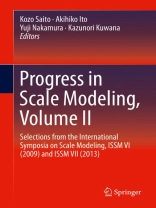This volume thoroughly covers scale modeling and serves as the definitive source of information on scale modeling as a powerful simplifying and clarifying tool used by scientists and engineers across many disciplines. The bookelucidates techniques used when it would be too expensive, or too difficult, to test a system of interest in the field. Topics addressed in the current edition include scale modeling to study weather systems, diffusion of pollution in air or water, chemical process in 3-D turbulent flow, multiphase combustion, flame propagation, biological systems, behavior of materials at nano- and micro-scales, and many more. This is an ideal book for students, both graduate and undergraduate, as well as engineers and scientists interested in the latest developments in scale modeling.
This book also:
- Enables readers to evaluate essential and salient aspects of profoundly complex systems, mechanisms, and phenomena at scale
- Offers engineers and designers a new point of view, liberating creative and innovative ideas and solutions
- Serves the widest range of readers across the engineering disciplines and in science and medicine
Table of Content
Introduction: Scale Modeling in the Age of High Speed Computation.- Part I: Natural Disasters and Structural Failures.- Section A: Earthquake.- Scale Modeling in the Geotechnical Engineering Field.- Supercomputing and Scale Modeling the Effect of Flotsam Mixed Tsunami: Implication to Tsunami Generated by the 2011 Great East Coast Earthquake.- Section B: Fire and Explosion.- Scale Modeling of Biomass Fire Associated with Hydrogen Producing Bacteria.- A Study of Flame Spread in Engineered Cardboard Fuelbeds: Part I: Correlations and Observations of Flame Spread.- A Study of Flame Spread in Engineered Cardboard Fuelbeds: Part II: Scaling Law Approach.- Application of Pressure Fire Modeling Under Low Pressure.- Observation of Confined Deflagration Phenomena of Flammable Gas Mixtures Under Elevated Gravity.- Extinguishment Characteristics of a Jet Diffusion Flame with Inert Gas Vortex Ring.- Effect of Gravity on Flame Spread Along a Thin Combustible Solid for Different Sample Orientations in Opposed-Flow.- Scale Effects on Consequence Analysis of Accidental Explosions.- Preliminary Reduced Scale Experimental Study on Pool Fires in Tunnels.- Scale-Model Experiment of Wind-Generated Fire Whirls.- Section C: Structures.- Seismic Behavior of Batter-Pile Foundation Based on Centrifuge Tests.- Characteristics of the Windmill Structural Fatigue Load in Natural Wind.- Part II: Engineering Design Performance Evaluation And Fundamental Understanding Using Scale Models.- Characteristics of Temperature-Fields and Flow-Fields in a Heated Street Canyon by Scale Modeling.- A Study of the Transition from Natural Convection to Force Convection in Plain and Louvered Fins with Scaling Simulations.- Scale and Numerical Modeling of an Air-Based Density Separator.- Scale-Up of Chemical Looping Combustion.- Scale Effect on Solid Fuel Regression in CAMUI Hybrid Rocket Motor.- Scale Effect Analysis for Locomotion Systems in Different Gravity Fields.- Scale Modeling of Flame Spread over PE-coated Electric Wires.- Scale Modeling of Air-Dropped Water for Aerial Firefighting against Urban Fire.- Effect of Porosity on Flame Spread Along Thin Combustible Solid with Randomly Distributed Pores.- Epilogue: Scale Modeling and Meditation.
About the author
Dr. Kozo Saito is affiliated with the University of Kentucky. Dr. Akihiko Ito is affiliated with Hirosaki University. Dr. Kazunori Kuwana is affiliated with Yamagata University. Dr. Yuji Nakamura is affiliated with Toyohashi University of Technology.












